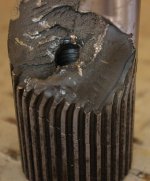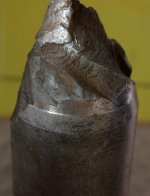FredC
Diamond
- Joined
- Oct 29, 2010
- Location
- Dewees Texas
A mechanic friend has been working on this new 60 hour tractor. The tractor had only pulled a shredder till the point where the rear axle broke. The tractor got stuck in wet sand and that is where the axle broke off with the wheel laying next to the tractor. The John Deere mechanics said the owner had tied something to the wheels and caused the axle to break. Owner says no. I looked at the tractor frame and fenders and saw no evidence that anything had wedged in there to break the axle.
My friend the mechanic asked me to look at the axle and I found that it was twisted, the metal grain looks like what I would expect. The splines and bearing races, and sealing surfaces are very hard and a new file does not cut them. They have a little bit finer grain pattern. Under the case the steel has a courser grain pattern and can be cut with a file. In between areas do not have the hard case, not sure how that was done, but it makes since to me that they would not need to be surface hard.
Three of the 4 photos I made are attached. Is there something obvious in the heat treatment that would indicate bad heat treat? My mechanic friend says that nothing you could do to a 65 horse - 4 wheel drive tractor should break an axle. I can see his point of view on this as the same tractor could have a 100 horse engine, so how can a 65 break it.
I see the dealer's point of view that the axle is definitely twisted near the splines and is heat treated as expected. I can bring the axle here again if another photo is needed. As far as I know only John Deere mechanics and no factory rep has seen this tractor.
Also the inboard tapered roller bearing is broken with split rollers and races broken, I kind of think that was done afterwards as the axle fell out. If the bearing had come unglued first I think it would have just spun on the axle and there are no marks indicating that



My friend the mechanic asked me to look at the axle and I found that it was twisted, the metal grain looks like what I would expect. The splines and bearing races, and sealing surfaces are very hard and a new file does not cut them. They have a little bit finer grain pattern. Under the case the steel has a courser grain pattern and can be cut with a file. In between areas do not have the hard case, not sure how that was done, but it makes since to me that they would not need to be surface hard.
Three of the 4 photos I made are attached. Is there something obvious in the heat treatment that would indicate bad heat treat? My mechanic friend says that nothing you could do to a 65 horse - 4 wheel drive tractor should break an axle. I can see his point of view on this as the same tractor could have a 100 horse engine, so how can a 65 break it.
I see the dealer's point of view that the axle is definitely twisted near the splines and is heat treated as expected. I can bring the axle here again if another photo is needed. As far as I know only John Deere mechanics and no factory rep has seen this tractor.
Also the inboard tapered roller bearing is broken with split rollers and races broken, I kind of think that was done afterwards as the axle fell out. If the bearing had come unglued first I think it would have just spun on the axle and there are no marks indicating that







 But here goes ...
But here goes ...